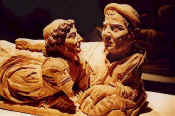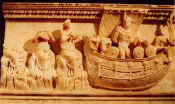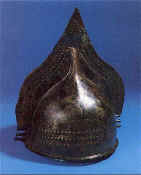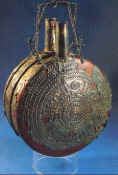The Guarnacci museum is one of the earliest public museums in Europe.
It was founded in 1761 when the noble abbot Mario Guarnacci (Volterra 1701-1785) , a collector of antiquities, donated his
archaeological collection to the citizens of the city of Volterra. The donation also included a rich library of more than
50,000 volumes. This donation turned out to be a far-sighted gesture, for Guarnacci not only prevented the dispersal of the contents of
Etruscan burial sites but also bequeathed a prestigious cultural heritage to
Volterra.
History
and culture of Tuscany.
Guarnacci was an erudite historian who also published Le Origini Italiche
(Lucca 1767), a controversial publication that generated lively criticism
within historical circles and thus attracted the attention of great intellectuals such as Giovanni Lami, Scipione Maffei and Anton Francesco Gori who promptly published
numerous articles on the subject, many of which were featured in magazines such as “Le Novelle letterarie” published in Florence and edited by
Lami.
The first Museum was housed in Palazzo Maffei (in Via Matteotti, Via Guidi
at that time) which was purchased by Guarnacci to house his collection. At his death in 1785, the collection was transferred
to the 13 C Palazzo dei Priori. In 1877, the director Niccolò Maffei transferred the museum,
which had been enriched by donations, purchases and further excavations,
to the Palazzo Desideri Tangassi.
Maffei exhibited the artefacts according to 19 C criteria. The cinerary urns were and are still displayed according to the theme carved on the lower case of the urns and the other items according to their typology.
This system for displaying the antiquities has recently been updated with the addition of exhibits placed in chronological order
so that the visitor may more easily obtain a comprehensive overview of the historical development of the Etruscan Velathri.
The ground floor elucidates the Villanovan, Orientalising, Archaic and Classic eras and continues on the second floor where the economic and artistic splendour of Etruscan Volterra from the
fourth to the first centuries B.C. is comprehensively exhibited.
A visit of the museum begins with the early Iron Age ninth to eighth centuries
B.C. In Room I, burial goods from the necropolis of the Badia and the Guerrucia excavated in
1892/1898 are exhibited. In Room I bis treasures from a Warriors Tomb have recently been added to the collection after an accidental
find in 1996 of a rare, exquisitely- manufactured, bronze crested helmet, a laminated bronze flask
and items pertaining to a warrior.
Very few items dating to the Orientalising Period (seventh century) have been found in Volterra and thus particularly significant
are a bucchero Kyathos from
Monteriggioni
bearing a dedicatory inscription, a series of bronze votive figurines and some remarkable jewellery from the tomb in Gesseri di Berignone (Volterra) donated to the museum by Bishop Incontri in 1839.
|
Make the best of your vacation
in Tuscany!
Learn some Italian from a
professional Italian language teacher in Chianti.

More
about
Italian
lessons in Tuscany.
|
|
The funeral stele of Avile Tite, one of the most renowned items of the Guarnacci collection,
dates to the archaic period (sixth century B.C.) and portrays a warrior wielding a lance and sword similar in style to
those in Greek-Oriental works of art.
In the centre of Room III are items from the fifth century B.C: a scarab in carnelian with a Greek inscription bearing the name of the artist (Lysandros), an Attic Krater attributed to a late production of the Berlin Painter and a calque of a masterpiece of Etruscan sculpture, the so-called Lorenzini Head, possibly a
deity and one of the earliest examples of a marble cult figure in northern Etruria.
The visit continues on the second floor which displays reconstructed tombs and burial furnishings of the Hellenistic Period (
fourth to the first century B.C.). The main feature of the collection is the cinerary urn typical of Volterra and its territory. In fact, the rite of cremation was almost exclusive to this
area. The ashes were ceremoniously placed in the urn, similar to a small sarcophagus.
The lid usually represents a recumbent figure attending a luxurious banquet feast, a social occasion also
attended by the Etruscan women and held in disrepute by the Romans and Greeks.
In this section of the museum, recently excavated tombs have been meticulously reconstructed. The family tombs display an array of burial furnishings which the relatives placed by the funeral monument, symbolically
committing the deceased to the underworld. Many of the items pertain to the banquet, vases to mix water and
wine, jugs and drinking vessels and others are ornamental or and personal items.
In Rooms XXVII and XXVIII, there are urns and burial furnishings from the Badia necropolis from the
third and second centuries B.C. Room XXIX is dedicated to the reconstruction of an artisanal workshop exhibiting the utensils still used
today by the alabaster artisans here in Volterra. In Room XXX, there is a collection of alabaster urns of exquisite workmanship. Alabaster, a local stone, was
utilised exclusively for the production of the cinerary urns.
In Room XXXI, scenes from Greek mythology and the voyage to the world beyond
are illustrated in wide range of themes. Rooms XXXII and XXIIa are dedicated to the theme of “portraiture” which concludes the section on the urns.
During the Hellenistic period there was a profuse production of artefacts in bronze and
ceramic: mirrors, votive figurines, vases, locally minted coins and black and red figure
vases (Rooms XXXVI and XXXVII).
In Room XXXV, sculptures and funeral monuments are displayed. The Mother and
Child (the so-called kourotrophos Maffei) with a dedicatory inscription (III century B:C..) is particularly noteworthy.
At the entrance fragments of terracotta decorations from the temple excavated on the
acropolis are displayed.
The Guarnacci Collection
Rooms III-IX on the ground floor and Rooms XIII-XXVI on the first floor display the nucleus of the original collection. The exhibit dates back to 1877 and consists of more than 600 cinerary urns displayed according to theme:
Room IV - Ornamental Motifs (demons masks and rosettes);
Room V - Fantastic and Ferocious animals;
Room VI-the Final Leave-taking;
Room VII -The voyage to the underworld on Horseback;
Room VIII -The voyage in a covered wagon (carpentum);
Room IX- The Voyage in a four-horsed chariot (quadriga).
The first floor exhibits urns portraying scenes from Greek mythology.
Room XVI -The Trojan cycle: Cadmus killing the dragon, Actaeon devoured by his hounds, the Execution of Dirce, Oedipus and the Sphinx, the Seven against Thebes.
Room XVII - The Recognition of Paris as son of Priam, the Rape of Helen, Telephus in the Greek camp, Philoctetes abbandoned on the island of Lemnos, the Arrival of the Amazons in aid of Priam, the Sacrifice of
the Trojan prisoners.
Room XIII - Athenian Sagas: Theseus and the Minotaur.
Room XVII -The Rape of the Leucippidae.
Room XIV - Argive myths: Perseus and Andromeda
Room XVIII - Pelops and Hippodamia. Some scenes are from the Odyssey: Ulysses and the sirens, the Blinding of Polyphemus, the changing of Ulysses sailors into animals, the Massacre of the suitors
Room XX exhibits the splendid Urn of the Married couple an exquisitely detailed sculpture in terra cotta,
portraying a recumbent elderly couple (first century B.C.).
In the centre of Room XXII stands the elongated, filiform votive figure of a young boy known as
"Ombra della Sera" ("Shadow of the Evening"). Its
notoriety, enriched by legends, is essentially due to the unusually- proportioned shape of this bronze statuette, an exquisite example of
third century BC Etruscan sculpture.
The first floor also contains a beautiful collection of Roman mosaics from buildings of Imperial Rome here in Volterra or from Segalari (Castagneto carducci) and an impressive collection of coins with rare examples of Etruscan coins in gold, silver and bronze, more than three thousand Greek, Roman Republican and Imperial coins, bronze
figurines (Room XXIV), jewellery and gems (Room XXV).
A visit of the first floor concludes with Room XXVI dedicated to the Roman era . Many of the items were found within the city walls and at the Roman theatre including the inscription bearing the name of the Caecina family who commissioned the construction of the theatre during the reign of Augustus and Tiberius.
Funerary epigraphs in latin from Rome, Volterra and the surrounding area adorn the stairway.
|





